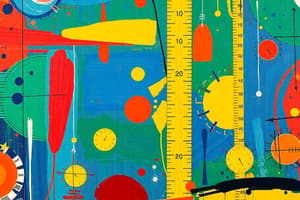Podcast
Questions and Answers
What is the primary purpose of the international system of units (SI)?
What is the primary purpose of the international system of units (SI)?
- To provide a common system of measurement for scientists around the world (correct)
- To measure the chemical properties of substances
- To create a system of measurement that is unique to each country
- To convert between different units of measurement
What is the SI unit used to measure length and distance?
What is the SI unit used to measure length and distance?
- Ampere
- Kilogram
- Kelvin
- Metre (correct)
What is the symbol for the SI unit of mass?
What is the symbol for the SI unit of mass?
- g
- l
- m
- kg (correct)
How many grams are equal to one kilogram?
How many grams are equal to one kilogram?
What is the SI unit used to measure temperature?
What is the SI unit used to measure temperature?
What is the SI unit used to measure luminous intensity?
What is the SI unit used to measure luminous intensity?
What is the SI unit used to measure the amount of substance?
What is the SI unit used to measure the amount of substance?
How many base units are there in the international system of units (SI)?
How many base units are there in the international system of units (SI)?
What is a characteristic of physical quantities?
What is a characteristic of physical quantities?
Why was the international system of units (SI) developed?
Why was the international system of units (SI) developed?
What is the purpose of SI base units?
What is the purpose of SI base units?
What is the symbol for the SI unit of time?
What is the symbol for the SI unit of time?
What is the symbol for the SI unit of luminous intensity?
What is the symbol for the SI unit of luminous intensity?
What is the SI unit used to measure electrical current?
What is the SI unit used to measure electrical current?
What is the purpose of the metre in the SI system?
What is the purpose of the metre in the SI system?
What is the relationship between the kilogram and the gram?
What is the relationship between the kilogram and the gram?
What is the symbol for the SI unit of mass?
What is the symbol for the SI unit of mass?
What is the purpose of the Kelvin in the SI system?
What is the purpose of the Kelvin in the SI system?
Flashcards are hidden until you start studying
Study Notes
Physical Quantities
- Physical quantities are characteristics of matter that can be observed without changing the chemical makeup of a substance.
- Examples of physical quantities include length, mass, color, and scent.
International System of Units (SI)
- The SI is an international system of measurements of physical quantities that originated from the metric system.
- The SI was developed when scientists worldwide agreed to use a common system for scientific work.
- The SI is the most widely used system of measurement, especially in scientific work.
- The abbreviation "SI" is based on the system's French name, Système Internationale d'Unités.
SI Base Units or Basic Quantities
- The SI consists of seven base units or basic quantities, from which other units are derived.
- The seven base units of the SI are:
- Metre (m) - used to measure length and distance
- Kilogram (kg) - used to measure mass, equal to 1,000 grams
- Second (s) - used to measure time
- Kelvin (K) - used to measure temperature
- Ampere (A) - used to measure electrical current
- Candela (Cd) - used to measure luminous intensity or brightness
- Mole (mol) - used to measure the amount of substance
Physical Quantities
- Physical quantities are characteristics of matter that can be observed without changing the chemical makeup of a substance.
- Examples of physical quantities include length, mass, color, and scent.
International System of Units (SI)
- The SI is an international system of measurements of physical quantities that originated from the metric system.
- The SI was developed when scientists worldwide agreed to use a common system for scientific work.
- The SI is the most widely used system of measurement, especially in scientific work.
- The abbreviation "SI" is based on the system's French name, Système Internationale d'Unités.
SI Base Units or Basic Quantities
- The SI consists of seven base units or basic quantities, from which other units are derived.
- The seven base units of the SI are:
- Metre (m) - used to measure length and distance
- Kilogram (kg) - used to measure mass, equal to 1,000 grams
- Second (s) - used to measure time
- Kelvin (K) - used to measure temperature
- Ampere (A) - used to measure electrical current
- Candela (Cd) - used to measure luminous intensity or brightness
- Mole (mol) - used to measure the amount of substance
Studying That Suits You
Use AI to generate personalized quizzes and flashcards to suit your learning preferences.




